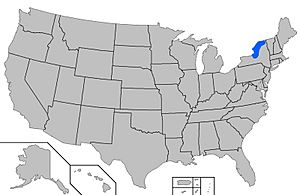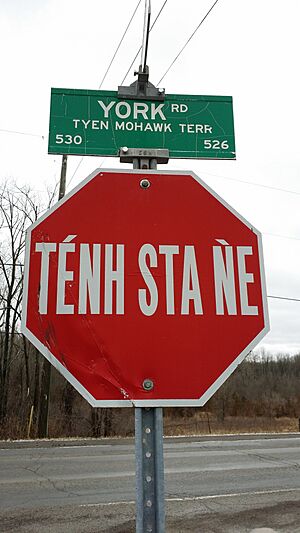Mohawk language facts for kids
Quick facts for kids Mohawk |
||||
|---|---|---|---|---|
| Kanienʼkéha Kanyenʼkéha |
||||
| Pronunciation | IPA: [ɡa.njʌ̃ʔ.ˈɡe.ha] | |||
| Native to | United States, Canada | |||
| Region | Ontario, Quebec and northern New York | |||
| Ethnicity | Mohawk people | |||
| Native speakers | 3,875 (2011-2016) | |||
| Language family | ||||

current distribution of Mohawk speakers in the United States.
|
||||
|
||||
Mohawk (pronounced "MOH-hawk") is an Iroquoian language spoken by about 3,500 people of the Mohawk nation. Most speakers live in Canada (in southern Ontario and Quebec) and some in the United States (in western and northern New York).
The Mohawk people call their language Kanienʼkéha, which means "language of the Flint Place." They call themselves Kanienʼkehá꞉ka, meaning "People of the Flint Stone Place" or "People of the Flint Nation."
The Mohawks were very successful traders. Other nations in their group, the Haudenosaunee, needed their flint for making tools. Their neighbors, the Mohicans, called them "Maw Unk Lin" or Bear People. The Dutch explorers heard this and wrote it as "Mohawks," which is how the name became common. The French also had their own names for the Mohawk people, like Aigniers or Maquis.
Contents
Mohawk Language: A Look Back
The Mohawks were the largest and strongest of the original Five Nations. They controlled a huge area of land on the eastern edge of the Iroquois Confederacy. The North Country and Adirondack regions of Upstate New York were mostly Mohawk-speaking areas until the late 1700s.
Understanding Mohawk Words
You can find online dictionaries for Mohawk, like ‘FirstVoices’ and ‘Kanien’kéha’. These tools help translate Mohawk words into other languages. However, it's important to know that many Mohawk words express feelings or ideas that don't have a direct translation. This can make dictionaries helpful but also tricky.
To truly understand Mohawk, it's best to learn it as a language and culture, not just through word lists. Dictionaries are good for starting, but they can sometimes miss the deeper meanings and cultural connections.
Mohawk Language: Today's Status
The Mohawk language is currently considered "threatened." This means the number of people who speak it as their first language has been going down.
Even so, Mohawk has the most speakers among the Northern Iroquoian languages. It's the only one with more than a thousand speakers left. People are working hard to bring the language back!
For example, in Akwesasne, a Mohawk community, they started a language immersion school for young children (from pre-kindergarten to 8th grade). In these schools, children learn everything in Kanienʼkéha. When the children learn, their parents and other family members often take language classes too!
The Akwesasne Freedom School was started in 1979 by Mohawk parents who wanted their children to have an education based on their culture. In 1985, the school began teaching all subjects in Mohawk. Their lessons are based on traditional ceremonies and the Mohawk Thanksgiving Address, called Ohén꞉ton Karihwatékwen, or "The words before all else." Every morning, teachers and students say the Thanksgiving Address in Mohawk.
An adult immersion program was also created in 1985. This program helps older generations learn or relearn the language, so it can be passed down to younger family members.
Kanatsiohareke (Gah-nah-jo-ha-lay-gay), which means "Place of the clean pot," is a small Mohawk community in New York. It was created in 1993 to be a place where Mohawk language and culture are taught. The community holds cultural events, workshops, and an annual Strawberry Festival to help support itself. They also have a craft shop with handmade Native crafts.
The main goal of Kanatsiohareke is to keep traditional Mohawk values, culture, language, and ways of life alive, following the Kaienerekowa (Great Law of Peace).
In 2006, over 600 people in Canada were reported to speak Mohawk, but many of them were elderly.
Kahnawake is another Mohawk community located near Montreal, Quebec, Canada. Because it's close to a big city, many people in Kahnawake speak English and French. This has led to a decrease in Mohawk language use over the past century. To fight this, the Mohawk Survival School, the first immersion program, was started in 1979. It aimed to bring the Mohawk language back. Early results showed that teaching younger generations was successful, with more people speaking Mohawk at home and mixing it into English conversations.
How Many People Speak Mohawk Today?
In 2011, there were about 3,500 Mohawk speakers, mostly in Quebec, Ontario, and western New York. Immersion classes for young children in places like Akwesasne are helping to create new first-language speakers. In the 2016 Canadian census, 875 people said Mohawk was their only mother tongue.
Mohawk in Pop Culture
The Mohawk language has appeared in several popular movies and video games:
- In the 2012 video game Assassin's Creed III, the main character, Ratonhnhaké꞉ton (also called Connor), is half-Mohawk and speaks the language.
- In Sid Meier's Civilization V, the character Hiawatha, who represents the Iroquoian civilization, speaks modern Mohawk.
- The short film 'Raising The Words' (2016) shows personal stories about people learning Mohawk in Tyendinaga Mohawk Territory.
- The Mohawk language is also used in the films Mohawk and Black Robe, and the TV series Barkskins.
Different Ways to Speak Mohawk
Mohawk has three main dialects, or regional variations:
- Western (spoken in Ohswé:ken and Kenhté:ke)
- Central (spoken in Ahkwesáhsne)
- Eastern (spoken in Kahnawà꞉ke and Kanehsatà꞉ke)
The main differences between these dialects are in how certain sounds are pronounced. For example, the sound for 'r' and some groups of consonants might be said differently.
Mohawk Sounds
An interesting thing about Mohawk is that it doesn't have sounds like 'm', 'p', 'b', 'f', or 'v' (which are made with the lips). These sounds only appear in a few words borrowed from French and English. This shows they were added to Mohawk after Europeans arrived.
Mohawk also has both regular vowels (like 'a', 'e', 'i', 'o') and nasalized vowels (where air comes out of your nose, like the 'on' in French "bon"). Vowels can be long or short.
Stress and Tone
Mohawk words have both stress (which part of the word is emphasized) and tone (the pitch of your voice). This means that how you say a word can change its meaning. Stressed vowels can have different tones: high, low, rising, or falling.
In the standard way of writing Mohawk, a colon (:) is put after a vowel to show that it's a long sound.
How Mohawk is Written
Mohawk uses these letters: ⟨a e h i k n o r s t w y⟩, along with ⟨’⟩ (apostrophe) and ⟨꞉⟩ (colon). The way it's written was standardized in 1993.
The apostrophe ⟨ʼ⟩ is used for a sound called a glottal stop (like the sound in "uh-oh"). The colon ⟨꞉⟩ makes a vowel sound longer.
Mohawk Grammar: Building Words
Mohawk words are often much longer than English words. This is because they are made up of many small parts called morphemes, which are like building blocks of meaning. What might take many words in English can often be said in just one Mohawk word! This is called polysynthesis.
Nouns
Mohawk nouns (words for people, places, or things) have a specific structure:
- They start with a Nominal Prefix (a small part at the beginning). This prefix tells you things like gender, whether something is alive, and if it's one or many. It also shows that the word is a noun.
- Then comes the Noun Stem (the main part of the word).
- Sometimes, there's a Nominal Suffix (a small part at the end). These suffixes can tell you about location or qualities.
For example:
- oʼnenste means "corn." The o- prefix is often used for things found in nature.
- kanhoha means "door." The ka- prefix is often used for things made by humans.
Suffixes can add meaning. For example, onutaʼke means "on the hill," where -ke shows location. And kvjaʼkoʼwa means "sturgeon" or "big fish," where -koʼwa means "big" or "augmentative."
Verbs
Mohawk verbs (action words) are very complex! They are made of many morphemes that describe different grammar rules. A single Mohawk verb can express a whole sentence in English. The main parts of a verb are the verb root and a pronominal prefix (which tells you who is doing the action).
Mohawk verbs also use suffixes to show tense (when something happens), aspect (how an action unfolds over time), and modality (like possibility or necessity).
For example:
- katorats means "I hunt." It has three parts: the prefix k- (I), the verb root -atorat- (hunt), and the suffix -s (which shows it's a regular habit).
- ku-noruhkwa means "I love you." The ku- prefix shows the relationship between "I" and "you."
- ri-noruhkwa means "I love him." The ri- prefix shows the relationship between "I" and "him."
Noun Incorporation
One cool feature of Mohawk is noun incorporation. This is when a verb "absorbs" a noun into itself. It's like combining two words into one longer word.
For example:
- Instead of saying "Baby ate the meat," you can say Owiraʼa wahaʼwahrakeʼ, which means "Baby meat-ate."
- Waʼeksohareʼ means "She dish-washed" (combining "dish" and "wash").
- Wahanaʼtarakwetareʼ means "He bread-cut" (combining "bread" and "cut").
This makes Mohawk words very long and packed with meaning!
Learning Mohawk
Many places offer ways to learn Mohawk:
- Six Nations Polytechnic in Ohsweken, Ontario, has diploma and degree programs in Mohawk.
- The University of Waterloo in Waterloo, Ontario, started offering a Mohawk credit course in 2017.
There are also many resources for learning Mohawk on your own:
- Talk Mohawk and Speak Mohawk are phone apps with words, phrases, and the Thanksgiving Address.
- Rosetta Stone levels 1 and 2 (CD-ROM) for Mohawk.
- A collection of 33 vocabulary lessons from the Mohawk Language Custodian Association.
- Books like Kanyenʼkeha Tewatati (Let's Speak Mohawk) and Sathahitáhkhe' Kanienʼkéha.
- FirstVoices is a free online tool with videos, text, pictures, and games to help you learn and teach the language.
Keyboards for Mohawk
You can type in Mohawk on computers! Software packages are available for both Microsoft Windows and Mac operating systems. These are offered through FirstVoices, a project that helps Indigenous people teach and save their languages and cultures.
Images for kids
See also
 In Spanish: Idioma mohawk para niños
In Spanish: Idioma mohawk para niños




